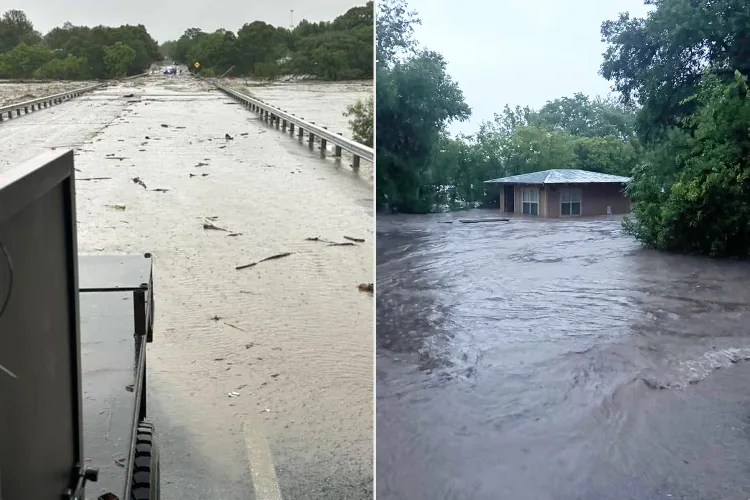NEWS
Texas city disappears underwater after Texas River rises over 25 feet in 45mins bursts banks and drowns multiple locals leaving many dead and destroying properties

July 5, 2025 — Parts of Central Texas have been devastated by a catastrophic flash flood after the Guadalupe River surged over 25 feet within 45 minutes, swallowing homes, camps, and entire communities near Kerrville, roughly 90 miles northwest of San Antonio.
A Sudden, Deadly Surge
Torrential rainfall—ranging between 5 and 11 inches in a few hours—triggered what officials are calling one of the worst flash floods in state history. The Guadalupe River surged to a staggering 34.7 feet, its second-highest level ever recorded.
Entire neighborhoods were overwhelmed, with floodwaters rising so rapidly that residents had little to no time to evacuate. Roads became rivers. Homes were ripped from their foundations. Cars were swept downstream.
️ Homes, Camps, and Lives Washed Away
- The Blue Oak RV Park and Riverside RV Park were entirely washed out. Many residents barely escaped.
- A summer program at Camp Mystic reported 20 to 25 girls missing, prompting a frantic search by ground and air teams.
- Entire sections of Kerrville were left unrecognizable, submerged under muddy, fast-moving water. Key bridges and highways were closed indefinitely.
♂️ Human Cost: Tragedy Strikes
- At least 24 people have been confirmed dead, including children.
- Dozens more remain missing as search and rescue operations continue.
- Many survivors recounted waking to a roar of rushing water, with just moments to grab loved ones and flee.
- Hundreds have been rescued by helicopters and boats, while shelters struggle to handle the sudden influx of displaced residents.
️ Emergency Response Underway
- A statewide disaster declaration was issued, activating emergency resources and drawing in state and federal agencies.
- The Texas National Guard, U.S. Coast Guard, and FEMA are conducting widespread rescue and recovery efforts.
- Over 2,600 homes lost power, and Kerrville’s water treatment plant was knocked offline, disrupting access to clean water.
Officials acknowledged that the speed of the flooding outpaced early warning systems, leaving many residents unaware of the danger until it was too late.
️ Climate Concerns Loom Large
Experts point to climate change as a major factor in the intensity of this disaster. Years of drought left soil too hard to absorb water quickly, turning heavy rain into instant runoff. This created a perfect storm: more water, faster floods, greater destruction.
Meteorologists are calling this a “1-in-100-year event”—but warn that such events are becoming more frequent due to warming global temperatures and shifting weather patterns.
Final Thoughts
This tragic flood in Central Texas is not just a natural disaster—it’s a human one. Families have lost loved ones, homes, and entire communities in mere minutes. As the waters slowly recede, the focus will shift to rescue, recovery, and rebuilding—but also to reflection.
Texas must now face tough questions about infrastructure, emergency preparedness, and climate resilience. For many, the road ahead will be long and painful. But it is also a moment for unity, support, and swift action to prevent future tragedies.












